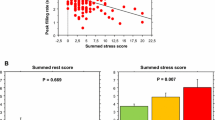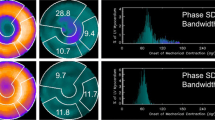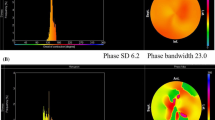Abstract
Myocardial infarction often leads to regional wall motion defects and in case of large defects to remodeling of the left ventricle. With this study, changes in regional and global myocardial function of 12 patients 3 weeks after myocardial infarction and after revascularization therapy were determined using MRI. Cine MRI was performed at study entry at rest and during low-dose dobutamine stimulation. All patients were re-examined at rest 3 and 6 months after the revascularization, including analysis of wall thickening and of left ventricular end-diastolic volume index (LVEDVI), end-systolic volume index (LVESVI), ejection fraction (LVEF), and mass index. After revascularization, 6 patients with stress-induced improvement of regional wall thickening recovered, 4 patients without improvement did not, but 2 patients without stress-induced improvement of wall thickening also recovered. Concerning global cardiac function, patients with mainly improved regional wall motion also showed a lower LVESVI and a higher LVEF than patients without improvement of regional contractility 6 months after revascularization in comparison to study entry. In conclusion, improvement of global myocardial function after revascularization is higher in patients with improved contractility in the infarcted region. The extent of the response of regions with wall motion defects to dobutamine stress correlates with the actual improvement after revascularization, and, therefore, dobutamine stress MRI may be helpful in selecting patients that will have a higher benefit from a revascularization therapy.
Similar content being viewed by others
References
Glasser SP. The time course of left ventricular remodeling after acute myocardial infarction. Am J Cardiol 1997; 80: 506–507.
Pierard LA, DeLandsheere CM, Berthe C, Rigo P, Kulbertus HE. Identification of viable myocardium by echocardiography during dobutamine infusion in patients with myocardial infarction after thrombolytic therapy: comparison with PET. J Am Coll Cardiol 1990; 15: 1021–1031.
Kloner RA. Coronary angioplasty: a treatment option for left ventricular remodeling after myocardial infarction? J Am Coll Cardiol 1992; 20: 314–316.
Kramer CM, Rogers WJ, Geskin G, Power TP, Theobald TM, Hu YL, Reichek N. Usefulness of magnetic resonance imaging early after acute myocardial infarction. Am J Cardiol 1997; 80: 690–695.
Sakuma H, Globits S, Bourne MW, Shimakawa A, Foo TK, Higgins CB. Improved reproducibility in measuring LV volumes and mass using multicoil breath-hold cine MR imaging. JMRI 1996; 1: 124–127.
Semelka RC, Tomei E, Wagner S, Mayo J, Kondo C, Suzuki JI, Caputo GR, Higgins CB. Normal left ventricular dimensions and function: interstudy reproducibility of measurements with cine MR imaging. Radiology 1990; 174: 763–768.
Cranney GB, Lotan CS, Dean L, Baxley W, Bouchard A, Pohost GM. Left ventricular volume measurement using cardiac axis nuclear magnetic resonance imaging. Validation by calibrated ventricular angiography. Circulation 1990; 82: 154–163.
Hundley WG, Li HF, Willard JE, Landau C, Lange RA, Meshack BM, Hillis LD, Peshock RM. Magnetic resonance imaging assessment of the severity of mitral regurgitation. Comparison with invasive techniques. Circulation 1995; 92: 1151–1158.
Holman ER, Buller VGM, de Roos A, van der Geest RJ, Baur LHB, van der Laarse A, et al. Detection and Quantification of dysfunctional myocardium by magnetic resonance imaging. A new three-dimensional method for quantitative wall-thickening analysis. Circulation 1997; 95: 924–931.
Sandstede J, Bertsch G, Beer M, Kenn W, Werner E, Pabst T, Lipke C, Kretschmer S, Neubauer S, Hahn D. Detection of Myocardial Viability by Low-Dose Dobutamine Cine MR Imaging. Magn Reson Imaging (in press).
Baer FM, Theissen P, Schneider CA, Voth E, Sechtem U, Schicha H, Erdmann E. Dobutamine magnetic resonance imaging predicts contractile recovery of chronically dysfunctional myocardium after successful revascularization. J Am Coll Cardiol 1998; 31: 1040–1048.
Lawson MA, Johnson LL, Coghlan L, Alami M, Tauxe EL, Reinert SE, Singleton R, Pohost GM. Correlation of thallium uptake with left ventricular wall thickness by cine magnetic resonance imaging in patients with acute and healed myocardial infarcts. Am J Cardiol 1997; 80: 434–441.
Mallory GK, White PD, Salcedo-Salgar J. The speed of healing of myocardial infarction. A study of the pathologic anatomy in seventy-two cases. Am Heart J 1939; 18: 647–671.
Kramer CM, Rogers WJ, Theobald TM, Power TP, Geskin G, Reichek N. Dissociation between changes in intramyocardial function and left ventricular volumes in the eight weeks after first anterior myocardial infarction. J Am Coll Cardiol 1997; 30: 1625–1632.
Eitzman D, al-Aouar Z, Kanter HL, vom Dahl J, Kirsh M, Deeb GM, Schwaiger M. Clinical outcome of patients with advanced coronary artery disease after viability studies with positron emission tomography. J Am Coll Cardiol 1992; 20: 559–565.
Di Carli MF, Davidson M, Little R, Khanna S, Mody FV, Brunken RC, et al. Value of metabolic imaging with positron emission tomography for evaluating prognosis in patients with coronary artery disease and left ventricular dysfunction. Am J Cardiol 1994; 73: 527–533.
Hammermeister KE, DeRouen TA, Dodge HT. Variables predictive of survival in patients with coronary disease. Selection by univariate and multivariate analyses from the clinical, electrocardiographic, exercise, arteriographic, and quantitative angiographic evaluations. Circulation 1979; 59: 421–430.
White HD, Norris RM, Brown MA, Brandt PW, Whitlock RM, Wild CJ. Left ventricular end-systolic volume as the major determinant of survival after recovery from myocardial infarction. Circulation 1987; 76: 44–51.
Author information
Authors and Affiliations
Rights and permissions
About this article
Cite this article
Sandstede, J.J., Lipke, C., Kenn, W. et al. Cine MR imaging after myocardial infarction – Assessment and follow-up of regional and global left ventricular function. Int J Cardiovasc Imaging 15, 435–440 (1999). https://doi.org/10.1023/A:1006342810026
Issue Date:
DOI: https://doi.org/10.1023/A:1006342810026




